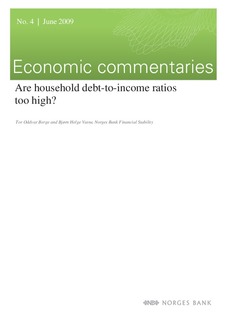| dc.contributor.author | Berge, Tor Oddvar | |
| dc.contributor.author | Vatne, Bjørn Helge | |
| dc.date.accessioned | 2018-08-23T07:42:29Z | |
| dc.date.available | 2018-08-23T07:42:29Z | |
| dc.date.issued | 2009 | |
| dc.identifier.uri | http://hdl.handle.net/11250/2558960 | |
| dc.description.abstract | Household debt growth has been high over the past 8‐9 years and it has been far higher than growth in disposable income. As a result, the household interest burden has risen sharply and is now at a historically high level [...] Outstanding debt for private households, wage earners and benefit recipients is now about twice as high as their disposable income, i.e. a debt burden of around 200 per cent. Due to the recent reduction in bank lending rates, the household interest burden, i.e. interest expenses as a share of income, is nevertheless fairly moderate. However, lending rates will normalise again over time. In this Commentary, we examine the relationship between the debt burden, the interest burden and lending rates. | nb_NO |
| dc.language.iso | eng | nb_NO |
| dc.publisher | Norges Bank | nb_NO |
| dc.relation.ispartofseries | Economic Commentaries;4/2009 | |
| dc.rights | Attribution-NonCommercial-NoDerivatives 4.0 Internasjonal | * |
| dc.rights.uri | http://creativecommons.org/licenses/by-nc-nd/4.0/deed.no | * |
| dc.title | Are Household Debt-To-Income Ratios Too High? | nb_NO |
| dc.type | Others | nb_NO |
| dc.description.version | publishedVersion | nb_NO |
| dc.subject.nsi | VDP::Samfunnsvitenskap: 200::Økonomi: 210::Samfunnsøkonomi: 212 | nb_NO |
| dc.source.pagenumber | 2 | nb_NO |

